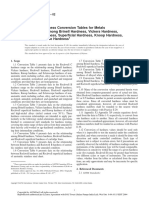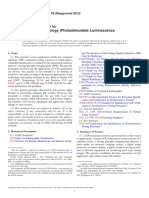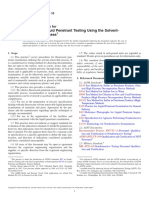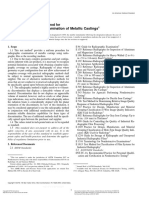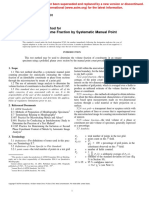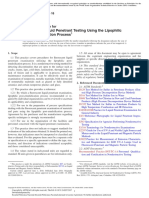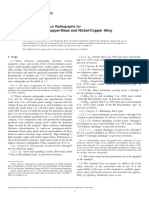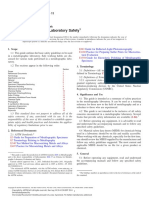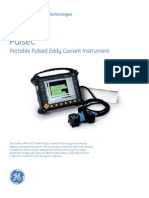0 ratings0% found this document useful (0 votes)
180 viewsElectromagnetic (Eddy-Current) Examination of Seamless and Welded Tubular Products, Austenitic Stainless Steel and Similar Alloys
Electromagnetic (Eddy-Current) Examination of Seamless and Welded Tubular Products, Austenitic Stainless Steel and Similar Alloys
Uploaded by
Damian Vega GThis practice 2 covers procedures that may be followed for eddy-current Examination of Seamless and Welded Tubular Products. Austenitic chromium-nickel stainless steels, which are generally considered to be nonmagnetic, are specifically covered. This standard does not purport to address all of the safety problems, if any, associated with its use.
Copyright:
© All Rights Reserved
Available Formats
Download as PDF, TXT or read online from Scribd
Electromagnetic (Eddy-Current) Examination of Seamless and Welded Tubular Products, Austenitic Stainless Steel and Similar Alloys
Electromagnetic (Eddy-Current) Examination of Seamless and Welded Tubular Products, Austenitic Stainless Steel and Similar Alloys
Uploaded by
Damian Vega G0 ratings0% found this document useful (0 votes)
180 views4 pagesThis practice 2 covers procedures that may be followed for eddy-current Examination of Seamless and Welded Tubular Products. Austenitic chromium-nickel stainless steels, which are generally considered to be nonmagnetic, are specifically covered. This standard does not purport to address all of the safety problems, if any, associated with its use.
Original Description:
Original Title
E426
Copyright
© © All Rights Reserved
Available Formats
PDF, TXT or read online from Scribd
Share this document
Did you find this document useful?
Is this content inappropriate?
This practice 2 covers procedures that may be followed for eddy-current Examination of Seamless and Welded Tubular Products. Austenitic chromium-nickel stainless steels, which are generally considered to be nonmagnetic, are specifically covered. This standard does not purport to address all of the safety problems, if any, associated with its use.
Copyright:
© All Rights Reserved
Available Formats
Download as PDF, TXT or read online from Scribd
Download as pdf or txt
0 ratings0% found this document useful (0 votes)
180 views4 pagesElectromagnetic (Eddy-Current) Examination of Seamless and Welded Tubular Products, Austenitic Stainless Steel and Similar Alloys
Electromagnetic (Eddy-Current) Examination of Seamless and Welded Tubular Products, Austenitic Stainless Steel and Similar Alloys
Uploaded by
Damian Vega GThis practice 2 covers procedures that may be followed for eddy-current Examination of Seamless and Welded Tubular Products. Austenitic chromium-nickel stainless steels, which are generally considered to be nonmagnetic, are specifically covered. This standard does not purport to address all of the safety problems, if any, associated with its use.
Copyright:
© All Rights Reserved
Available Formats
Download as PDF, TXT or read online from Scribd
Download as pdf or txt
You are on page 1of 4
Designation: E 426 98 An American National Standard
Standard Practice for
Electromagnetic (Eddy-Current) Examination of Seamless
and Welded Tubular Products, Austenitic Stainless Steel
and Similar Alloys
1
This standard is issued under the xed designation E 426; the number immediately following the designation indicates the year of
original adoption or, in the case of revision, the year of last revision. A number in parentheses indicates the year of last reapproval. A
superscript epsilon (e) indicates an editorial change since the last revision or reapproval.
This specication has been approved for use by agencies of the Department of Defense.
1. Scope
1.1 This practice
2
covers procedures that may be followed
for eddy-current examination of seamless and welded tubular
products made of stainless steel and similar alloys such as
nickel alloys. Austenitic chromium-nickel stainless steels,
which are generally considered to be nonmagnetic, are speci-
cally covered as distinguished from the martensitic and ferritic
straight chromium stainless steels which are magnetic.
1.2 This practice is intended as a guide for eddy-current
examination both seamless and welded tubular products using
either an encircling coil or a probe-coil technique. Coils and
probes are available that can be used inside the tubular product;
however, their use is not specically covered in this document.
This type of examination is usually employed only to examine
tubing which has been installed such as in a heat exchanger.
1.3 This practice covers the examination of tubular products
ranging in diameter from 0.125 to 5 in. (3.2 to 127.0 mm) and
wall thicknesses from 0.005 to 0.250 in. (0.127 to 6.4 mm).
1.4 The values stated in inch-pound units are to be regarded
as the standard.
1.5 This standard does not purport to address all of the
safety problems, if any, associated with its use. It is the
responsibility of the user of this standard to establish appro-
priate safety and health practices and determine the applica-
bility of regulatory limitations prior to use.
2. Referenced Documents
2.1 ASTM Standards:
E 543 Practice for Agencies Performain Nondestructive
Testing
3
E 1316 Terminology for Nondestructive Testing
3
2.2 Other Documents:
SNT-TC-1A Recommended Practice for Personnel Quali-
cation and Certication in Nondestructive Testing
4
ANSI/ASNT CP-189 ASNT Standard for Qualication and
Certication of Nondestructive Testing Personnel
4
MIl-STD-410E Nondestructive Testing Personnel Quali-
cation and Certication
5
NAS-410 NAS Certication and Qualication of Nonde-
structive Personnel (Quality Assurance Committee)
6
3. Terminology
3.1 Standard terminology relating to electromagnetic ex-
amination may be found in Terminology E 1316, Section C,
Electromagnetic Testing.
4. Summary of Practice
4.1 The test is conducted using one of two general tech-
niques shown in Fig. 1. One of these techniques employs one
or more exciter and sensor coils which encircle the pipe or tube
and through which the tubular product to be inspected is
passed. Some circuit congurations employ separate exciter
and sensor coils; whereas other congurations employ one or
more coils that concurrently function as both exciters and
sensors. Alternating current passes through the exciting coil
which by reason of its proximity induces current in the tubular
product. The sensor coil detects the resultant electromagnetic
ux related to these currents. The presence of discontinuities in
the tubular product will affect the normal ow of currents and
this change is detected by the sensor. The encircling coil
technique is capable of inspecting the entire 360-deg expanse
of the tubular product.
4.2 Another technique employs a probe coil with one or
more exciters and sensors which is brought in close proximity
of the surface of the tubular product to be examined. Since the
probe is generally small and does not encircle the article being
examined, it examines only a limited area in the vicinity of the
probe. If it is desired to examine the entire volume of the
1
This practice is under the jurisdiction of ASTM Committee E-7 on Nonde-
structive Testing and is the direct responsibility of Subcommittee E07.07 on
Electromagnetic Methods.
Current edition approved Dec. 10, 1998. Published February 1999. Originally
published as E 426 71. Last previous edition E 426 92.
2
For ASME Boiler and Pressure Vessel Code applications see related Practice
SE-426 in Section II of that Code.
3
Annual Book of ASTM Standards, Vol 03.03.
4
Available from American Society for Nondestructive Testing, 1711 Arlingate
Plaza, P.O. Box 28518, Columbus, OH 432280518.
5
Available from Standardization Documents Order Desk, Bldg. 4, Section D,
700 Robbins Ave., Phila., PA 191115904, Attn: NPODS.
6
Available from Aerspace Industries Association of America, Inc., 1250 Eye
Street, N.W., Washington, DC 20005.
1
AMERICAN SOCIETY FOR TESTING AND MATERIALS
100 Barr Harbor Dr., West Conshohocken, PA 19428
Reprinted from the Annual Book of ASTM Standards. Copyright ASTM
tubular product, it is common practice to either rotate the
tubular product or the probe. In the case of welded tubular
products frequently only the weld is examined by scanning
along the weld zone.
5. Signicance and Use
5.1 Eddy-current testing is a nondestructive method of
locating discontinuities in a product. Changes in electromag-
netic response caused by the presence of discontinuities are
detected by the sensor, amplied and modied in order to
actuate audio or visual indicating devices, or both, or a
mechanical marker. Signals can be caused by outer surface,
inner surface, or subsurface discontinuities. The eddy-current
test is sensitive to many factors that occur as a result of
processing (such as variations in conductivity, chemical com-
position, permeability, and geometry) as well as other test
factors not related to the tubing. Thus, all received indications
are not necessarily indicative of defective tubing.
6. Basis of Application
6.1 If specied in the contractual agreement, personnel
performing examinations to this practice shall be qualied in
accordance with a nationally recognized NDT personnel quali-
cation practice or standard such as ANSI/ASNT-CP-189,
SNT-TC-1A, MIL-STD-410E, NAS-410, ASNT-ACCP, or a
similar document and certied by the certifying agency, as
applicable. The practice or standard used and its applicable
revision shall be identied in the contractual agreement be-
tween the using parties.
NOTE 1MIL-STD-410 is canceled and has been replaced with NAS-
410, however, it may be used with agreement between contracting parties.
6.2 If specied in the contractual agreement, NDT agencies
shall be qualied and evaluated in accordance with Practice
E 543. The applicable edition of Practice E 543 shall be
specied in the contractual agreement.
7. Apparatus
7.1 Electronic ApparatusThe electronic apparatus shall
be capable of energizing the test coils or probes with alternat-
ing currents of suitable frequencies and shall be capable of
sensing the changes in the electromagnetic response of the
sensors. Equipment may include a detector, phase discrimina-
tor, lter circuits, modulation circuits, magnetic-saturation
devices, recorders, and signaling devices as required for the
particular application.
7.2 Test CoilsTest coils shall be capable of inducing
current in the tube and sensing changes in the electrical
characteristics of the tube.
NOTE 2Fill factor effect is an important consideration since coupling
variations can affect the test signicantly.
7.3 Probe CoilsProbe coils shall be capable of inducing
current in the tube and sensing changes in the electrical
characteristics of the tube (Note 3). Probes generally consist of
an exciting coil and sensing coil or Hall element mounted in a
common holder. A Hall element is a semiconductor that by
reason of the Hall effect is capable of responding in a manner
directly proportional to magnetic-ux density. However, when
used with an exciting coil, it should be remembered that
eddy-current ow is inuenced by the excitation frequency.
NOTE 3Lift-off effect is an important consideration since coupling
variations can affect the test signicantly.
7.4 Driving MechanismA mechanical device capable of
passing the tube through the test coil or past the probe. It shall
operate at a uniform speed with minimum vibration of coil,
probe, or tube and maintain the article being examined in
proper register or concentricity with the probe or test coil.
Where required, the mechanism shall be capable of uniformly
rotating the tube or probe.
7.5 Reference StandardThe standard used to adjust the
sensitivity setting of the apparatus shall be sound and of the
same nominal alloy, temper, and nominal dimensions as the lot
of tubes or pipes to be tested on a production basis. It shall be
of sufficient length to permit the required spacing of the
articial discontinuities (at least 4 ft, and preferably longer).
Articial discontinuities made in the tube or pipe shall be
centered as nearly as possible on one inside or outside diameter
surface of the tube and shall preferably be of one of the
following types:
7.5.1 HolesHoles that are usually drilled completely
through the wall may be used. Care should be taken during
drilling to avoid distortion of the tube (or pipe) and hole.
FIG. 1 Sketch Showing Encircling-Coil and Probe-Coil
Techniques for Electromagnetic Examining of Tubular Products
E 426
2
7.5.2 NotchesNotches may be produced by electric dis-
charge machining (EDM), milling, or other means. Longitudi-
nal or transverse notches or both may be used (Note 4).
Orientation, dimensions (width, length, and depth), and con-
guration of the notches affect the response of the eddy-current
system. Notch depth is usually specied as a percentage of
nominal wall thickness of the tubular product being examined.
Notches may be placed on the outer, inner, or both surfaces of
the reference (calibration) standard. Outer surface notches
provide an indication of system response to discontinuities
originating on the outer tube surface, whereas inner surface
notches provide an indication of system response to disconti-
nuities originating on the inner tube surface (Note 5).
NOTE 4Longitudinal notch standards are normally used when exam-
ining with rotating probe systems.
NOTE 5The density of eddy currents decreases nearly exponentially
with increasing distance from the surface nearest the coil, and the
sensitivity to subsurface discontinuities decreases with the change in depth
allowing the use of phase analysis techniques.
7.5.3 The conguration, orientation, and dimensions (diam-
eter of holes and the width, length, and depth of notches) of the
articial discontinuities to be used for establishing acceptance
limits should be subject to agreement between supplier and
purchaser.
8. Adjustment and Standardization of Apparatus
Sensitivity
8.1 Select the apparatus, test frequency, coil or probe, or
both, design, phase discrimination, and other circuitry as well
as speed of examining which shall demonstrate the system
capability for detecting the discontinuities of interest.
8.2 Fabricate the applicable reference standard in accor-
dance with the agreement between the purchaser and tubing
supplier.
8.3 Adjust the apparatus to obtain an optimum signal-to-
noise ratio with the minimum sensitivity required to detect the
articial discontinuities in the reference standard. Do this
under conditions (such as testing speed) identical to those to be
used in production examination of the tubular products.
8.4 Determine the end effect by using a special reference
tube or pipe containing a series of notches or holes near one or
both of the ends and passing this reference standard through the
system at production testing speeds. If notches or holes are
placed near only one of the ends, pass the tube through the
system backwards and forwards.
9. Procedure
9.1 Standardize the apparatus at the start of the test run
using the reference standard. The recommended maximum
interval between restandardization is 4 h although more or less
frequent restandardization may be done by agreement between
using parties, or whenever improper functioning of the equip-
ment is suspected. If improper functioning is found, restan-
dardize the apparatus and retest all tubes or pipes tested during
the period since the last successful standardization.
9.2 Pass the lot of tubes or pipes to be tested through the test
coil or past the probe coil of the apparatus adjusted to the
sensitivity as described in Section 8. Set aside tubes or pipes
with discontinuities indicated by the apparatus. It is recom-
mended that tubes with discontinuity indications be reexam-
ined or retested in accordance with the purchase specication.
9.3 Tubes or pipes may be tested in the nal drawn,
annealed, heat treated, as-welded, or other step in processing.
The point in processing at which inspection is made should be
agreed upon by the supplier and the purchaser. The tubes
should be free of any substance that may interfere with the test.
10. Supplemental Information Regarding Eddy-Current
Testing of High Alloy Steels and Similar Alloys
10.1 In the eddy-current testing of austenitic chromium-
nickel stainless steels it has been found that test frequencies
ranging from less than 1 kHz to more than 1 MHz can be used.
The more commonly used operating frequencies are in the
range, 1 kHz to 125 kHz. The exact frequency used will depend
on the application.
ExampleIf thin-walled tubular products are to be in-
spected or surface rather than subsurface discontinuities are to
be detected, higher frequencies are used. For heavy-walled
tubes, subsurface discontinuities well below the surface require
the use of a lower frequency. Choice of test frequency will
determine the size of discontinuity that can be detected.
10.2 As in any eddy-current test, the depth and orientation
of the discontinuity below the entry surface will affect the
magnitude of signal received from it. Sensitivity varies signi-
cantly with distance from the test coils.
10.3 Under certain conditions austenitic stainless steels can
be magnetic. For example, delta ferrite may be present in a
welded product. Permeability may vary as a function of cold
work. Some nickel alloys, such as Monel Alloy (nickel-copper
alloy), are magnetic in nature and others exhibit magnetism if
there are slight residual stresses in the material.
10.4 Welded stainless steel products can present a special
problem in eddy-current testing. The weld area can usually be
distinguished from the parent metal if the tubing has received
little or no working after welding. This occurs when the
as-welded structure contains delta ferrite which is magnetic
and can cause a high-background noise level or spurious
indications, or both. If drawn after welding, these effects may
be reduced so that welded tubing cannot be distinguished from
seamless tubing. These effects do not necessarily preclude the
eddy-current testing of as-welded tubing; however, the testing
apparatus will probably require different adjustments for ma-
terials with as-welded and wrought structures. Thus, the
minimum size discontinuity that can be detected may also be
different.
10.4.1 For inspecting as-welded tubing, a strong d-c mag-
netic eld is usually applied to improve the signal-to-noise
ratio. This bias eld is generally applied by an encircling coil
or yoke simultaneously with the eld from the test coil.
10.4.2 In preparing a reference standard for welded tubing,
articial discontinuities should be placed in both the weld
metal and the parent metal if both are to be inspected. The
apparatus is then adjusted to obtain an optimum signal-to-noise
ratio.
10.4.3 When inspecting only the weld area, the discontinui-
ties shall be placed in the weld area.
10.5 Certain austenitic chromium-nickel stainless steels ex-
hibit changes in magnetic properties as a result of cold work.
E 426
3
As a result, it may be desirable to prepare reference standards
from each lot of material in order to take into account the effect
of magnetic permeability. It may also be helpful to employ a
magnetic-saturation device to minimize the effects of varying
magnetic permeability.
10.6 Both the test frequency and the type of apparatus being
used should be considered when choosing the testing speed.
Certain types of equipment can detect discontinuities at very
slow speeds, while other types require a certain minimum
speed. The testing speed may need to be linked to the speed at
which the material is being processed at the point of inspection.
10.7 The response from natural discontinuities can be sig-
nicantly different than that from articial discontinuities such
as drilled holes or notches. For this reason, sufficient work
should be done to establish the sensitivity level and set-up
required to detect natural discontinuities of consequence to the
end use of the product.
11. Keywords
11.1 alloy; austenitic chromium-nickel stainless steels; aus-
tenitic stainless steels; conductivity; discontinuities; eddy-
curent; electromagnetic; encircling coil; hall element; non-
magnetic steels; probe coil; seamless tubular products; tubular
product; welded tubular products
The American Society for Testing and Materials takes no position respecting the validity of any patent rights asserted in connection
with any item mentioned in this standard. Users of this standard are expressly advised that determination of the validity of any such
patent rights, and the risk of infringement of such rights, are entirely their own responsibility.
This standard is subject to revision at any time by the responsible technical committee and must be reviewed every ve years and
if not revised, either reapproved or withdrawn. Your comments are invited either for revision of this standard or for additional standards
and should be addressed to ASTM Headquarters. Your comments will receive careful consideration at a meeting of the responsible
technical committee, which you may attend. If you feel that your comments have not received a fair hearing you should make your
views known to the ASTM Committee on Standards, 100 Barr Harbor Drive, West Conshohocken, PA 19428.
E 426
4
You might also like
- Astm e 192Document6 pagesAstm e 192Bryan Jimenes Dorantes0% (1)
- E213 - 2022 Standard Practice For Ultrasonic Testing of Metal Pipe and Tubing - PDF - Nondestructive Testing - Signal To Noise RatioDocument37 pagesE213 - 2022 Standard Practice For Ultrasonic Testing of Metal Pipe and Tubing - PDF - Nondestructive Testing - Signal To Noise RatioCoordinador Hseq Technodrill0% (1)
- E186-10 Standard Reference Radiographs For Heavy-Walled (2 To 41 2-In. (50.8 To 114-mm) ) Steel Castings PDFDocument4 pagesE186-10 Standard Reference Radiographs For Heavy-Walled (2 To 41 2-In. (50.8 To 114-mm) ) Steel Castings PDFVarunSharma100% (1)
- E1742-00 Radiographic ExaminationDocument14 pagesE1742-00 Radiographic Examinationphanthanhhung100% (1)
- Case 2235-9 2010Document10 pagesCase 2235-9 2010Jimmy Márquez100% (1)
- General Requirements For Flat-Rolled Nickel and Nickel Alloys Plate, Sheet, and StripDocument16 pagesGeneral Requirements For Flat-Rolled Nickel and Nickel Alloys Plate, Sheet, and StripIvan Alexandre LopesNo ratings yet
- Ferrite Measurement PDFDocument2 pagesFerrite Measurement PDFESWARANM91No ratings yet
- E 215 - 98 R04 - Rtixnq - PDFDocument7 pagesE 215 - 98 R04 - Rtixnq - PDFLeón SuárezNo ratings yet
- ASTM A456-Large Crankshaft ForgingsDocument4 pagesASTM A456-Large Crankshaft ForgingsMarisol VivianoNo ratings yet
- A275 - A275M 08 (2013) - STD - Practice - For - MPI - of - Steel - ForgingDocument7 pagesA275 - A275M 08 (2013) - STD - Practice - For - MPI - of - Steel - ForgingNiking ThomsanNo ratings yet
- BS en 3452 3 Penetrant Testing Reference BlocksDocument15 pagesBS en 3452 3 Penetrant Testing Reference BlocksKresimir SimeonNo ratings yet
- E3022-15 Standard Practice For MeasuremPPTDocument8 pagesE3022-15 Standard Practice For MeasuremPPTManuel Andres Mantilla DuranNo ratings yet
- E1815-01 Film System Classification PDFDocument6 pagesE1815-01 Film System Classification PDFalisyalalaNo ratings yet
- NDT Syallbus Anna University ScribdDocument2 pagesNDT Syallbus Anna University ScribdM.Saravana Kumar..M.ENo ratings yet
- Asme Section Ii A Sa-388 Sa-388m PDFDocument10 pagesAsme Section Ii A Sa-388 Sa-388m PDFdavid perezNo ratings yet
- General Requirements For Alloy and Stainless Steel PipeDocument12 pagesGeneral Requirements For Alloy and Stainless Steel Pipebehzad mohammadiNo ratings yet
- Scanner Cobra en 201507Document2 pagesScanner Cobra en 201507Shahbaz KhanNo ratings yet
- Astm A418 2020Document8 pagesAstm A418 2020Cristhian Camilo Quiroga WalterosNo ratings yet
- Astm E-1032Document5 pagesAstm E-1032Mustafa Ersin EkremNo ratings yet
- BS EN ISO 9934-1 Current CalculationDocument3 pagesBS EN ISO 9934-1 Current Calculationbhavin178No ratings yet
- ASTM E1475 - 02 (Stardard Guide For Data Fields For Computerized Transfer of Digital Ragiological Examination Data)Document5 pagesASTM E1475 - 02 (Stardard Guide For Data Fields For Computerized Transfer of Digital Ragiological Examination Data)Silvia Alejandra Caicedo CastellanosNo ratings yet
- Astm E1647Document4 pagesAstm E1647Jorge SuarezNo ratings yet
- Astm e 2446Document9 pagesAstm e 2446김경은No ratings yet
- ASTM E 1815 - 2008 Classification of Film Systems For Industrial Radiography1Document8 pagesASTM E 1815 - 2008 Classification of Film Systems For Industrial Radiography1grimaguilNo ratings yet
- E125 MP TestingDocument21 pagesE125 MP TestingDeepakRajurkar0% (1)
- Astm B906Document16 pagesAstm B906Jamil SalmanNo ratings yet
- BS 5998-83Document8 pagesBS 5998-83GaneshNo ratings yet
- Ultrasonic Comparison SNR PDFDocument78 pagesUltrasonic Comparison SNR PDFsoledenseNo ratings yet
- ASTM B363-06a PDFDocument4 pagesASTM B363-06a PDFScribdNo ratings yet
- Sae Ams-W-6858Document46 pagesSae Ams-W-6858Luis HernandezNo ratings yet
- PSM 5usage and MaintenanceDocument4 pagesPSM 5usage and MaintenanceNguyễn Đức BìnhNo ratings yet
- Ultrasonic Testing ExaminationsDocument2 pagesUltrasonic Testing ExaminationsRajakumaran Amr100% (1)
- Liquid Penetrant Testing: Standard Practice ForDocument11 pagesLiquid Penetrant Testing: Standard Practice ForMandy NormanNo ratings yet
- PFI ES 42 1996 Standard For PositiveDocument7 pagesPFI ES 42 1996 Standard For Positiveahmad effendiNo ratings yet
- E 2033 - 99 (2013)Document11 pagesE 2033 - 99 (2013)Enrique Antonio100% (2)
- E1219-10 Standard Practice For Fluorescent Liquid Penetrant Testing Using The Solvent - Removable Process PDFDocument6 pagesE1219-10 Standard Practice For Fluorescent Liquid Penetrant Testing Using The Solvent - Removable Process PDFManuel Andres Mantilla DuranNo ratings yet
- Astm e 1209Document6 pagesAstm e 1209KEN KNo ratings yet
- E1208 16 PDFDocument7 pagesE1208 16 PDFFrancisco PizarroNo ratings yet
- ASTM E 1030 00 Radiographic Examination of Metallic Castings1Document11 pagesASTM E 1030 00 Radiographic Examination of Metallic Castings1jra9090100% (1)
- Determining Volume Fraction by Systematic Manual Point CountDocument7 pagesDetermining Volume Fraction by Systematic Manual Point CountRahmat Ramadhan Pasaribu100% (1)
- E1208 720Document7 pagesE1208 720gerardomediavillaepnNo ratings yet
- Macro Test Details PDFDocument5 pagesMacro Test Details PDFNikesh Koli100% (1)
- RT Standards NotesDocument4 pagesRT Standards NotesprabhuNo ratings yet
- Astm A 312Document10 pagesAstm A 312abdelrahman EweesNo ratings yet
- ASME Code Case 2600 PDFDocument2 pagesASME Code Case 2600 PDFrotero_pujolNo ratings yet
- National Step Tablet Vs Step Wedge Comparision FilmDocument4 pagesNational Step Tablet Vs Step Wedge Comparision FilmManivannanMudhaliarNo ratings yet
- High-Strength Copper-Base and Nickel-Copper Alloy Castings: Standard Reference Radiographs ForDocument5 pagesHigh-Strength Copper-Base and Nickel-Copper Alloy Castings: Standard Reference Radiographs ForSarita SharmaNo ratings yet
- E2014-Metallographic Laboratory SafetyDocument8 pagesE2014-Metallographic Laboratory SafetyGeorgon MontoyaNo ratings yet
- AMS2643 Structural Examination of Titanium Alloys Chemical Etch Inspection Procedure Rev. EDocument5 pagesAMS2643 Structural Examination of Titanium Alloys Chemical Etch Inspection Procedure Rev. ERubén Eduardo Galindo CarmonaNo ratings yet
- BS en 10228-4-2016Document32 pagesBS en 10228-4-2016Sorin MirtNo ratings yet
- Astm B209-06Document29 pagesAstm B209-06Washington SouzaNo ratings yet
- High-Strength Copper-Base and Nickel-Copper Alloy Castings: Standard Reference Radiographs ForDocument5 pagesHigh-Strength Copper-Base and Nickel-Copper Alloy Castings: Standard Reference Radiographs ForSarita SharmaNo ratings yet
- Astm E309 16Document3 pagesAstm E309 16Prajna PrayasNo ratings yet
- Astm e 309Document5 pagesAstm e 309김경은No ratings yet
- Astm E243Document6 pagesAstm E243javierguillermo1983No ratings yet
- Electromagnetic (Eddy-Current) Examination of Seamless and Welded Tubular Products, Austenitic Stainless Steel and Similar AlloysDocument4 pagesElectromagnetic (Eddy-Current) Examination of Seamless and Welded Tubular Products, Austenitic Stainless Steel and Similar AlloysNathaniel LuraNo ratings yet
- Methodologies for Assessing Pipe Failure Rates in Advanced Water Cooled ReactorsFrom EverandMethodologies for Assessing Pipe Failure Rates in Advanced Water Cooled ReactorsNo ratings yet
- Ee3303 QB 02 2 MarkDocument32 pagesEe3303 QB 02 2 MarkganeshaetangedcoNo ratings yet
- Electromagnetic InductionDocument21 pagesElectromagnetic InductionParth GuptaNo ratings yet
- Book4 Resistivity PDFDocument345 pagesBook4 Resistivity PDFnitishNo ratings yet
- ANSI B30.8 InterpretationDocument10 pagesANSI B30.8 InterpretationAndreyNo ratings yet
- Maxwell 15 - 2D PDFDocument628 pagesMaxwell 15 - 2D PDFCata50% (2)
- Applsci 13 06097Document16 pagesApplsci 13 06097Srikanth SrikantiNo ratings yet
- Training Manual: Inductive SensorsDocument102 pagesTraining Manual: Inductive SensorsAmal TharakaNo ratings yet
- Single Cylinder Four Stroke Diesel Engine Test RigDocument24 pagesSingle Cylinder Four Stroke Diesel Engine Test RigDigvijay Todkar100% (1)
- Valid NDT StandardsDocument15 pagesValid NDT StandardsKonstantin LuzarevNo ratings yet
- EMINewDocument10 pagesEMINewMohith DasNo ratings yet
- Ls-Dyna Manual Volume III r9.0Document293 pagesLs-Dyna Manual Volume III r9.0mehdi jokarNo ratings yet
- Kyocera Mita KMIS Training MaterialDocument4 pagesKyocera Mita KMIS Training MaterialFredrick MuthokaNo ratings yet
- Class 12 Physics Mcqs Chapter: 6 Electromagnetic Induction: AnswerDocument12 pagesClass 12 Physics Mcqs Chapter: 6 Electromagnetic Induction: AnswerDiksha TNo ratings yet
- List of NDT Standards 10 2015 Corr PDFDocument16 pagesList of NDT Standards 10 2015 Corr PDFSatyabrata Kundu100% (2)
- 2017-20 - Condition Assessment - Water Distribution & Sewage Conveyance - LeeDocument19 pages2017-20 - Condition Assessment - Water Distribution & Sewage Conveyance - LeeTunde BabsNo ratings yet
- Nikola Tesla Notes On A Unipolar Generator The Electrical EngineerDocument10 pagesNikola Tesla Notes On A Unipolar Generator The Electrical EngineerDiego Betancourt MejiaNo ratings yet
- Eddy Current BrakesDocument25 pagesEddy Current BrakesRadu Lucian AlexandruNo ratings yet
- Astm E268Document4 pagesAstm E268AlbertoNo ratings yet
- Introduction To Eddy Current-LibreDocument401 pagesIntroduction To Eddy Current-Libresafeer ahmadNo ratings yet
- Eddy Current BrakesDocument24 pagesEddy Current BrakesMd Jawed AkhtarNo ratings yet
- Efficiency Improvement of 3 Phase Induction Motor: P.Palpandian, E.Arunkumar, K.Syril Jennifer PaulDocument11 pagesEfficiency Improvement of 3 Phase Induction Motor: P.Palpandian, E.Arunkumar, K.Syril Jennifer PaulDisha NayarNo ratings yet
- Walker, Chapter 23 Magnetic Flux and Faraday's Law of InductionDocument31 pagesWalker, Chapter 23 Magnetic Flux and Faraday's Law of InductionMohsin RazaNo ratings yet
- Electromagnetic Fields Two Mark Questions and AnswersDocument26 pagesElectromagnetic Fields Two Mark Questions and AnswersVenkatesan Satheeswaran100% (5)
- Ascham 2016 Physics Trials & SolutionsDocument39 pagesAscham 2016 Physics Trials & SolutionsNhan LeNo ratings yet
- Sources of Magnetic Field: General Physics Phys. 106Document127 pagesSources of Magnetic Field: General Physics Phys. 106hwuhwuheNo ratings yet
- Induction Heating Process Design Using Comsol Multiphysics Software Version 42aDocument4 pagesInduction Heating Process Design Using Comsol Multiphysics Software Version 42areaktorenergiNo ratings yet
- PulsecDocument4 pagesPulsecRocknee1No ratings yet
- Ge Runout BasicsDocument14 pagesGe Runout BasicsRajagopal100% (1)
- Induction Heating Coil DesignDocument20 pagesInduction Heating Coil Designbitconcepts9781100% (1)
























